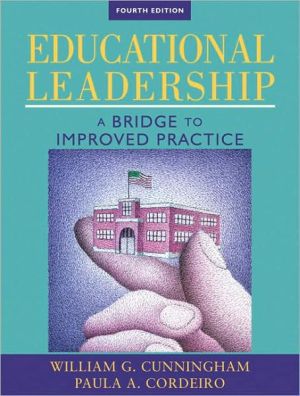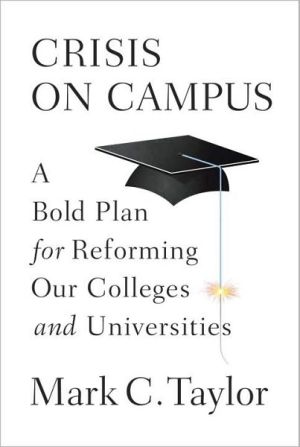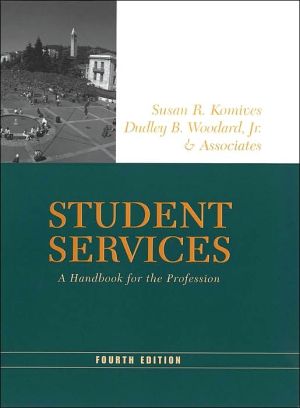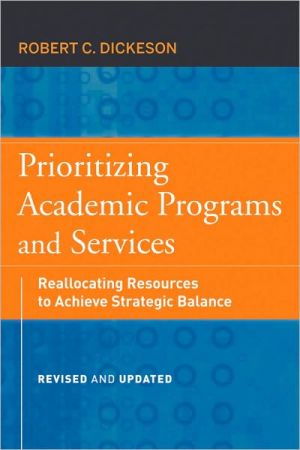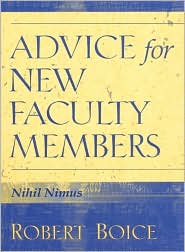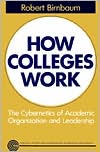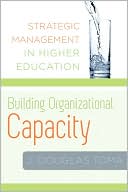Educational Leadership: A Bridge to Improved Practice
Educational Leadership: A Bridge to Improved Practice describes how successful and effective schools and administrators operate in an increasingly challenging, fast-paced, demanding, and at times revolutionary environment. Readers are offered an integrated view of the knowledge base, research, and practice of administration within a context of multiple perspectives and a wide range of thinking.\ This edition provides a comprehensive discussion of the field of educational administration in...
Search in google:
This text supports improved practice in educational administration that results in greater student learning in American schools. In this way, it is much more than an outstanding leadership theory and research text; it is also a highly usable, practical guide. This text improves the knowledge and practice of our future leaders by focusing on present conditions, operations, new directions, and best practices in American schools. This text successfully makes the important theory-to-practice transitions in a clearly written, fun to read format, with lots of hands on activities to draw students into the important content. The title of the text was changed in this new edition to reflect this important emphasis on its ability to improve educational practice. It is a must for any one serious about becoming an educational leader for American schools.
Preface 1 Administrative Theory, Values Clarification, and Leadership Responsibility • Flem Snopes High School: A New Administrative Team Educational Leadership Human Capital and the Accumulated Knowledge Base Administrative Process and Knowledge Philosophical Frames and Epistemological InfluencesParadigms and the Scientific-Rational ApproachPolitical, Critical, and Constructivist Frames of ReferenceCritical-Contextual, Gender, and RacePostmodernism, Poststructuralism• Grounding Moral Educational Leadership in the Intrinsically Moral Enterprise of Learning, by Robert J. StarrattEthical Models The Ethic of CaringThe Ethic of JusticeThe Ethic of CritiqueFoundations of Ethical Behavior: Standards for Good Practice Codes of EthicsAdministrative Platforms The Knowledge Base in Educational Administration • The Knowledge Base in Educational Administration: by Robert Donmoyer, The University of San DiegoConclusion Portfolio Artifacts Terms Suggested Readings 2 Context and Perspective for Educational Leaders • Nanuck Middle School: Understanding the Context Contextual Knowledge Broad, Complex Context Federal Turning-Points Education OriginsLand GrantReliefNational DefenseEqual Educational OpportunityWorld Class Economic Competitiveness and Support–1980 to PresentEstablishing National Goals • Thoughts for Leaders of Educational Institutions in Transition, by Luvern L. Cunningham, Novice G. Fawcett Professor of Educational Administration (Emeritus), The Ohio State UniversityThe 1990s and Beyond No Child Left BehindNew Technological Demands State Roles and Responses Equity and Social Justice Challenges in the Twenty-First Century Conclusion Portfolio Artifacts Terms Suggested Readings 3 School Reform • Scrivner Middle School: Reform at Scrivner • Leading Innovative Schools, by Stephanie Pace Marshall, Ph.D., Mathematics and Science Academy, Aurora, IllinoisThe Context for School Reform Finding New DirectionsCommon Themes in a Changing WorldInnovative Programs Other Innovative Models and Their Benefits• A Framework for School Improvement, by Carl Glickman, Lew Allen, and James Weiss, The University of GeorgiaHarnessing Technology Technology Opens New OpportunitiesAdministrative Applications• Wilson Elementary School District: Five Steps to a Successful Technology Program, by Jane M. Juliano, Ph.D., Principal, Wilson Charter High School, Phoenix, ArizonaThe Leadership Challenge Conclusion Portfolio Artifacts Terms Suggested Readings 4 Diversity and Community Relations • Oakes High School: Cultures Clash in Fairhaven Diversity in Schools Socioeconomic Status and Social ClassU.S. Population DemographicsCultural IdentityCultural TransitionsSexual IdentityPrejudice and Discrimination Discrimination in Schools Competing Perspectives: Theories, Models, and Approaches to Race, Class, and Gender Cultural Deficiency ApproachCultural Difference ApproachHuman Relations ApproachSingle-Group Studies ApproachMulticultural Education ApproachSocial Justice Education ApproachSegregation, Desegregation, and Integration Magnet SchoolsLanguage Diversity in U.S. Schools: Program OptionsEnglish Language Learners in U.S. Public Schools English Only, English Plus, and Programs for Nonstandard English Speakers• Developing Programs of School, Family, and Community Partnerships: Administrators Make a Difference, by Joyce L. Epstein, Director, Center on School, Family, and Community Partnerships, Johns Hopkins UniversityConnecting Schools and Community Organizations Conclusion Portfolio Artifacts Terms Suggested Readings 5 School District Organizational Structure and Leadership • Alta Vista School: Data Disaggregation The Local Role The Local School Division The School Board The School Division Superintendent Central Office Operations • Local School Structures and Arrangements, by Marilyn Tallerico, Syracuse UniversityThe School Administrator Changing RolesCritical IncidentsPolitics of the Principalship Principal: Instructional Leader or School Manager?School Safety Audit • Putting “Cs” into the Village, by Paul C. Houston, Ed.D., Executive Director, American Association of School AdministratorsParental Involvement Assistant Principal (AP) Conclusion Portfolio Artifacts Terms Suggested Readings Appendix 5.A: The Joint AASA—NSBA Superintendent Guidelines 6 Leadership Theory and Practice • Atlas Shrug High School: Failing Health Assessing Leadership Characteristics Paradigms of Leadership: A Growing Knowledge Base Leadership Instrument Analyses McGregor’s Theories X and YNREL Behavior MatrixEarly StudiesThe Ohio State StudiesThe New Managerial GridSituational and Contingency LeadershipUniversity of Michigan StudiesRecent Works on Leadership Search for ExcellenceThe 7 Habits of Highly Effective People and AlignmentThe Learning OrganizationThe New Science of LeadershipTotal Quality Management (TQM)School-Based Management (SBM)Cultural LeadershipTransformational LeadershipLeadership Traits or Skills Conclusion Portfolio Artifacts Terms Suggested Readings Appendix 6.A: Directions for Scoring Box 6.1: The X—Y Scale Appendix 6.B: Directions for Interpreting Box 6.4: The Behavior Matrix Appendix 6.C: Directions for Scoring Box 6.5: Leadership Behavior Survey Appendix 6.D: Directions for Scoring Box 6.6: Measuring Preferred Management Styles Appendix 6.E: Twenty-One Combined Domains of Effective School Leadership 7 Successful School Leadership • Packer Middle School: An Interview for a Principalship Leadership Matters Adult Learning Effective School Leadership Practices • Leadership and the Change Process, by Michael Fullan, University of TorontoStructures That Provide Opportunities for Teacher Collaboration Study GroupsInstructional Walk-ThroughsTeacher ConferencesSchool VisitationsDistrict and/or School Instructional Conferences• Principals as Instructional Leaders: Modeling and Supporting Teaching and Learning, by Paul V. Bredeson, University of Wisconsin—MadisonSupporting the Change Process The Teacher Selection Process Conclusion Endnote Terms Suggested Readings 8 Program Development, Delivery, and Assessment • XXXX Elementary School: Program Improvement Conceptions of Academic Achievement Theories of IntelligenceTypes of KnowledgeLearning Transfer 1Constructivism: A New Conception of LearningBuilding a Culture of LearningTeaching and Learning Approaches Apprenticeship LearningCooperative LearningProblem-Based and Project-Based LearningCurriculum Design and Educational Programming Functions of Curriculum• Principal as Curriculum Leader, by Allan A. Glatthorn, University of East CarolinaThe Standards MovementCurricular and Instructional Change Developing Curriculum and ProgramsDesigning and Managing the Curriculum• Seeing the Curriculum Whole: The Function of a Real Educational Leader, by Laurel N. Tanner, Temple UniversityProgram Improvement and Evaluation Utilizing Time Year-Round EducationBlock SchedulingLoopingTime on TaskAssessing Student Progress Portfolios• Assessing Student Performance, by Grant Wiggins, President and Director for the Center on Learning Assessment and School Structure (C.L.A.S.S.)Reporting Student ProgressPresenting Student Outcomes to the CommunityConclusion Portfolio Artifacts Terms Suggested Readings 9 Pupil Personnel Services • Edgar Allen Poe Middle School: Special Education Pupil Personnel—Student Service Team Counseling, Guidance, Psychological Services Special Education and Remedial Instruction Inclusion• Leadership for Special Services, by Judy Mantle, University of San DiegoSchool Health Services Child Accounting and School Safety School SecurityStudent DisciplinePupil Appraisal, Testing, and Diagnostics Extracurricular Activities Conclusion Portfolio Artifacts Terms Suggested Readings 10 Human Resource Management • Lincoln Elementary School: Staffing Problems Taking Care of the Staff Job Analysis, Classification, and Staff Planning Job AnalysisJob ClassificationStaff PlanningRecruitment Selection Alternative Selection Approaches Performance Appraisal and Evaluation Planning the EvaluationCollecting InformationUsing InformationStaff Development Employee Assistance and Wellness Programs• Human Resource Administration in the Third Millennium, by Ronald Rebore, St. Louis UniversityOrganizational Development Wage and Salary Considerations BenefitsCollective Bargaining Employee Records and Reports Employee Litigation Conclusion Portfolio Artifacts Terms Suggested Readings 11 Laws and Policies • XXX I.S.D: Not Following School Board Policy Legal Responsibility Learning about Schools and Legal IssuesThe U.S. Legal System Federal Role in EducationFederal Courts• Understanding Court Decisions, by Perry A. Zirkel and Kathleen A. Sullivan, Lehigh UniversityThe State’s Legal Role in EducationState Legislatures, Administrative Agencies, and Local Boards of ControlSchool Districts and LitigationLegal Issues and Schools Due ProcessFreedom of Speech and ExpressionDiscipline and Students with DisabilitiesThe Confidentiality of Student Records• Teacher and Student Freedom of Expression, by Frank Kmerer, University of San DiegoTortsMonitoring Compliance with Policies and Procedures • Legal and Ethical Dimensions of Educational Leadership, by Martha McCarthy, Indiana UniversityConclusion Portfolio Artifacts Terms Suggested Readings Court Cases 12 Resource Allocation and Management • Oceanview School District: Identifying Funding Sources for Meadows High Financing Schools TaxesFederal Involvement in Financing Schools State Involvement in Financing Schools Local Involvement in Financing Schools Vouchers Nontraditional Revenue Sources School FoundationsRevenue Sources for Independent Schools • Obtaining Funding for Educational Programs, by Harvey B. Polansky, Ph.D., Superintendent of Schools, Southington, ConnecticutGrant Writing Budgeting, Accounting, and Facility Management The Budgeting ProcessTypes of Budgeting Line-Item BudgetingPlanning, Programming, Budgeting System (PPBS) 34Zero-Based BudgetingIncremental BudgetingTrends in Budgeting and ManagementActivity Funds Fiscal Accounting The Audit • Acquiring, Allocating, and Accounting for Resources, by Richard A. King, University of Northern ColoradoManaging School Supplies and Equipment Maintaining School Buildings and Grounds Conclusion Portfolio Artifacts Terms Suggested Readings 13 Problem-Based Learning Projects Problem-Based Learning • Problem-Based Learning in Educational Leadership, by Ed Bridges, Stanford University, and Philip Hallinger, Vanderbilt UniversityFacilitating Groups • Understanding Group Process, by Cheryl Getz, University of San Diego• Project 1: Safe Havens: Developing School-Based Health Clinics, by Ellen Smith Sloan, Southern Connecticut State University• Project 2: A Jalapeño in a Candy Jar: Addressing Cultural Diversity, by Paula A. Cordeiro, University of San Diego• Project 3: Atoms and Bits: A Technology Project, by Barbara S. Campbell, Wolcott Public School, Connecticut • Project 4: Data Management and Analysis (DMA) and Decision Making at Madison High School, by William G. Cunningham, Old Dominion University• Project 5: Marveling at the Results: Power, Roles, Relationships, and School Reform, by William G. Cunningham, Old Dominion UniversityReferences and Bibliography Name Index Subject Index
